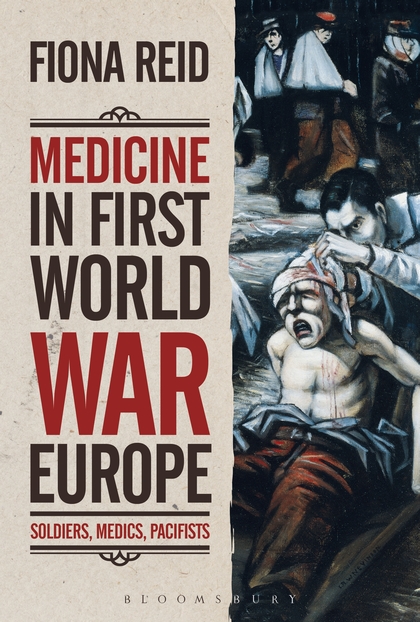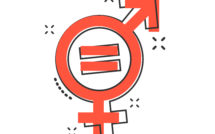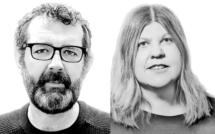

This is part of our special feature, Public Health.
To the question, “War, what it is good for?” some may be tempted to answer, “Medicine.” War kills, of course, but it also hurts, maims, and increases sickness and disease. This requires a response, not merely for the humanitarian motives of healing and reducing suffering, but also for the more utilitarian imperative of restoring bodies to economic and military productivity. Both of these purposes propel advances in medical science and treatment. The gigantic scope and unprecedented violence in Europe and across the globe between 1914 and 1918 drove new developments in diagnosis, preventative treatment, surgical procedures, the efficient organization of medical care, and many other areas. But these advances came at a price: doctors treating soldiers were officers, served the military and the state, and were primarily charged with rendering men fit to fight until victory or until they wore out or died. As Fiona Reid points out in her illuminating account of medicine on the Western Front, doctors were “part of a military compliance system” (13). And as for their patients, “As part of the fighting unit the potential sick soldier was essentially dehumanized; he was less of a man in need and more of a ‘weak point,’ a defective component in a much larger machine” (12). To resurrect the humanity of the men and women involved in this medical drama, Reid largely sets aside the question of whether or not war is “good for medicine” and focuses instead on “the ways in which individual men experienced health, medicine, and medical care during the war” (10). The result is an excellent history that will interest scholars of the First World War, the history of medicine, and modern European history more generally.
To the question, “War, what it is good for?” some may be tempted to answer, “Medicine.” War kills, of course, but it also hurts, maims, and increases sickness and disease. This requires a response, not merely for the humanitarian motives of healing and reducing suffering, but also for the more utilitarian imperative of restoring bodies to economic and military productivity. Both of these purposes propel advances in medical science and treatment. The gigantic scope and unprecedented violence in Europe and across the globe between 1914 and 1918 drove new developments in diagnosis, preventative treatment, surgical procedures, the efficient organization of medical care, and many other areas. But these advances came at a price: doctors treating soldiers were officers, served the military and the state, and were primarily charged with rendering men fit to fight until victory or until they wore out or died. As Fiona Reid points out in her illuminating account of medicine on the Western Front, doctors were “part of a military compliance system” (13). And as for their patients, “As part of the fighting unit the potential sick soldier was essentially dehumanized; he was less of a man in need and more of a ‘weak point,’ a defective component in a much larger machine” (12). To resurrect the humanity of the men and women involved in this medical drama, Reid largely sets aside the question of whether or not war is “good for medicine” and focuses instead on “the ways in which individual men experienced health, medicine, and medical care during the war” (10). The result is an excellent history that will interest scholars of the First World War, the history of medicine, and modern European history more generally.
Far from a straightforward narrative of medical treatment during the war, Reid’s account takes a thematic approach. It is important to note that this is not a global history, and that the focus is on the experiences of the three major combatants on the Western Front: Great Britain, France, and Germany. Moreover, the majority of the author’s evidence and examples derive from the British experience, and she makes use of comparatively few primary or secondary sources in French and virtually none in German. Nevertheless, the book covers the French and German experiences surprisingly well, through a wide-ranging engagement with the relevant events, issues, and personalities in all three nations. The result is essentially well balanced, and even when the focus falls disproportionately on Great Britain in the final substantive chapter, on Medical Pacifism, the uniqueness of the experience justifies the approach (and the fascinating and thorough account of the Friends Ambulance Unit contains a great deal of information about the French army for which the Quakers worked).
Reid follows the wounded and sick on their journeys to and from the front, to casualty clearing stations and hospitals, and sometimes to their homes. Her tale is rich in detail, fulfilling the promise she makes near the beginning of the book: “By accounting for the men’s pain, their treatment and their care, we can get a glimpse of the social and emotional history of men at war” (18). The miseries of the trenches, actually far less lethal than the combat in the open that began and ended the war, were legion: cold, wet, mud, lice, trench foot, sickness and disease, shrapnel and bullet and gas wounds. In Reid’s account, the focus is always on the experience of these, on the personal journeys of men through the wounding and medical landscape. She explains clearly how and why certain wounds became “iconic:” gas, shell shock, and facial injury, evoking the tragedy and pity of war in psychologically and culturally important ways, even if they actually occurred less frequently than other kinds of wounds. Her encyclopedic survey of the relevant history and scholarship on these topics is deeply impressive (not surprising from the author of a thorough history of shell shock in Britain during and after the war).[1] And her examination of pain, of the experience of being wounded and ways of confronting that pain—often alcohol, and sometimes illicit drugs or medicines sent from home or improvised on the spot—provides some of the clearest windows into the past as lived experience as readers are likely to encounter anywhere.
Throughout the book, Reid is admirably sensitive to the cultural resonances and meanings of the phenomena she explores, from seemingly “heroic” wounds—that were nonetheless vaguely shameful, crippling bodies and compromising manhood—to unambiguously unheroic self-inflicted and “blighty” wounds, still painful and sometimes even deadly but often bringing immense relief because they promised an escape from combat and perhaps even a permanent trip home (“blighty” was a synonym for “home” among British soldiers of the First World War). Reid’s perceptive readings of the evidence and cultural environment keep her always attentive to the role of gender, particularly masculinity, in the medical history of the war. This kind of insight is nowhere more evident than in her analysis of the pull of cultural demands felt even by pacifists and Quakers to be the right kind of man and find the right kind of war service (preferably caring for soldiers, not civilians, close to the fighting front) in order to save face during and after the war. Even those disgusted by war and committed to nonviolence wanted to be able to “tell their children a good story” about what they did during the war, “to do something more than simply to declare ‘we did not fight’” (188, 189). Even medical pacifists were still men, still products of the European culture that initiated and sustained appalling and colossal violence, suffering, and death for over four years at the beginning of the world’s bloody twentieth century.
Ultimately, Fiona Reid has written a book that captures the human dimensions of pain, suffering, and treatment in a war that mobilized, wounded, and killed millions. She has done this by telling a story of military and medical institutions that never loses sight of the individual men and women who peopled the “huge military-medical machine on the Western Front” (65). Her liberal and wide-ranging use of personal testimonies captures the drama and pathos, as well as the numbing brutality and drudgery, of suffering, witnessing, treating, and recovering from wounds. This was surely one of the most important and defining experiences of this first modern, industrial, global war, given that it wounded at least 20 million men, or one out of every three men mobilized. Mary Borden, an American novelist who served as a nurse to French soldiers on the Western Front throughout the war (whose striking evocation of “Pain” as soldiers’ “mistress” Reid notes when discussing the experience of wounding [115]), also conveys experiences on both sides of the divide between wounded and carer. In a story published after the war, she writes:
Looking back, I do not understand that woman—myself—standing in that confused goods yard filled with bundles of broken human flesh. The place by one o’clock in the morning was a shambles. The air was thick with steaming sweat, with the effluvia of mud, dirt, blood. The men lay in their stiff uniforms that were caked with mud and dried blood, their great boots on their feet; stained bandages showing where a trouser leg or a sleeve had been cut away. Their faces gleamed faintly, with a faint phosphorescence. Some who could not breathe lying down were propped up on their stretchers against the wall, but most were prone on their backs, staring at the steep iron roof.
And yet she was “happy” on this, “the second battlefield.” She was fulfilling a contract that Reid notes had developed in the minds of Europeans in the years before 1914: citizens owed the state allegiance and military service, but they also had a right to expect to receive organized, efficient, and effective medical care. The First World War strengthened this conviction—that governments must not abandon their damaged citizens. But in her story, one of Borden’s patients, blinded completely, begins to panic at the thought he was left alone, foresaken. Borden reassures him: “‘You are not alone,’ I lied. ‘There are many of your comrades here, and I am here, and there are doctors and nurses. You are with friends here, not alone.’” Yet she knows she is lying to him, that even in the middle of the crowded, chaotic, stinking floor of a busy field hospital every wounded man and every doctor, nurse, and orderly was alone with his or her pain and terror and fatigue.[2] These are the sorts of paradoxes that Reid describes so well. On the one hand, she makes clear the extent to which both soldiers and doctors had become embroiled in vast, “impersonal systems” (194). On the other hand, the “shared medical history” of medical personnel and soldiers, “indicates that the survivors of the Great War were humanized rather than brutalized by their experiences” (195).
We might say the same of Reid’s work: she has humanized the men and women of the past, making their unimaginable experiences of war and pain and caring accessible to us. In doing so, she has rendered exceptionally well the sort of service historians owe both to their readers and to the people who make and live the history we read.
Reviewed by Richard S. Fogarty, University at Albany, State University of New York
Medicine in First World War Europe: Soldiers, Medics, Pacifists
By Fiona Reid
Publisher: Bloomsbury
Paperback / 263 pages / 2017
ISBN: 9781472513243
To read more book reviews click here.
Published on June 11, 2019.
[1] Fiona Reid, Broken Men: Shell Shock, Treatment and Recovery in Britain, 1914-1930 (London: Bloomsbury, 2010).
[2] Mary Borden, “Blind,” in The Penguin Book of First World War Stories, eds. Ann-Marie Einhaus and Barbara Korte (New York: Penguin, 2007), 71 and 76. Originally published in Borden’s The Forbidden Zone (London: William Heinemann, 1929).




